Wound Healing Society Newsletter Volume 3 Issue 2
Wound Healing Society Newsletter Volume 3 Issue 2
Wound Healing Society Newsletter Volume 3 Issue 2
You also want an ePaper? Increase the reach of your titles
YUMPU automatically turns print PDFs into web optimized ePapers that Google loves.
The <strong>Wound</strong> <strong>Healing</strong> <strong>Society</strong> <strong>Newsletter</strong> <strong>Volume</strong> 3 <strong>Issue</strong> 2<br />
For example, many of the diabetic models induce<br />
profound hyperglycemia in younger animals than<br />
what is experienced in human type II diabetes.<br />
Moreover, nearly all animal studies are carried out in<br />
juvenile animals, which hardly represent the biology<br />
of most patients with chronic wounds.<br />
Gabriel Sosne of Wayne State University used his<br />
presentation on “Thymosin beta 4: From Bench<br />
to Bedside” to move the discussion on preclinical<br />
models away from the laboratory and towards<br />
the unique hurdles in translational wound healing<br />
medicine. He described the development of thymosin<br />
b4 as an ophthalmologic treatment for a number of<br />
conditions. This peptide is currently in several clinical<br />
trials for repair of many tissues under a program<br />
sponsored by Regenerx.<br />
Dr. Sosne showed how the pre-clinical and clinical<br />
trial findings in rat corneal burn and epithelial injury<br />
and in vitro based assays were used to establish<br />
both the efficacy and safety of treatment. These<br />
findings resulted in FDA approval for compassionate<br />
use in epidermolysis bullosa and later diabetic and<br />
neurotrophic corneal ulcers. Dr. Sosne reported on<br />
current phase II clinical trials for dry eye syndrome,<br />
and then described the details of the process that is<br />
required to move a data information package of safety<br />
data, pharmacokinetic data, preclinical observations,<br />
and clinical compassionate need through FDA<br />
approval.<br />
The third presentation was a comprehensive<br />
discourse on the regulatory process by Michael<br />
Sabolinski on “Pre-Clinical and Clinical Trial<br />
Design for Regulatory Approval.” As former CEO<br />
of Organogenesis and a regulatory consultant<br />
(Aalnex), Dr. Sabolinski stressed that, from the FDA<br />
perspective, the primary value of preclinical studies<br />
is in the development of a safety portfolio, echoing<br />
the sentiment that animal models are an imperfect<br />
prelude to the critical stage of clinical trials. The<br />
scientific evidence of efficacy in animal models<br />
takes a lesser role than issues such as toxicity,<br />
pharmacokinetics, carcinogenesis, and teratogenicity<br />
in the case of pharmacologic approaches.<br />
Device development follows a different regulatory<br />
pathway that generally requires different preclinical<br />
testing, since the objective is to demonstrate<br />
equivalent performance rather than superiority arising<br />
from a physical rather than biochemical interaction<br />
with host tissue. The presentation included a detailed<br />
flow chart of the regulatory process and a step-by-step<br />
presentation of the various regulatory hurdles and<br />
obstacles to approval. Dr Sabolinski concluded his<br />
segment with an illustration of exemplary preclinical<br />
data that were used to obtain approval for Apligraf.<br />
This excellent overview led to a wide-ranging, thought<br />
provoking brainstorming discussion. Seven panels of<br />
participants were each charged with assessing one<br />
of the following topics: preclinical models of scar<br />
formation, infection, ischemia, diabetes, replacement/<br />
regeneration, metabolic models, and human models.<br />
For each topic, they were asked to review the most<br />
common approaches being used, their advantages and<br />
their disadvantages.<br />
When pressed to recommend the “ideal” model,<br />
the consensus of each panel was predictably the<br />
same: there is no perfect model. Instead, participants<br />
argued for the deployment of a combination of the<br />
complementary models as the key to performing<br />
accurate, reproducible, and scientifically sound<br />
science. The specific choice of animal models<br />
depends on the ultimate goal(s): basic science seeks<br />
to understand mechanisms, IND-enabling studies<br />
seek to explore efficacy, and IND models must test<br />
translational suitability.<br />
Although different panels identified different<br />
weaknesses of different models, there were a number<br />
of common themes that emerged from the group<br />
discussions while the panels presented their findings.<br />
For example, there was concern that pre-clinical models<br />
have a tendency to become somewhat contrived for<br />
both scientific and economic reasons. As scientists,<br />
we always seek to refine, reduce, and replace, while<br />
always maintaining the scientific integrity of our work.<br />
But does the genetic, epigenetic, nutritional, and<br />
environmental homogeneity of our animal models help,<br />
or harm, the application of data to the real world?<br />
In addition, there was discussion of the need for<br />
investigators to begin (in the laboratory) with the<br />
end in mind (in the clinic) when choosing different<br />
models. Finally, the specter of the economic reality<br />
of preclinical work was discussed. Whereas some<br />
models might be more predictive of outcome, the<br />
prohibitive cost precludes their deployment for most<br />
investigators.<br />
The WHS is very much interested in employing<br />
its members to participate in an ongoing<br />
discussion of this topic with a goal of formulating<br />
recommendations for specific pre-clinical models. To<br />
this end we plan to develop a web-based forum that<br />
will capture the ongoing dialogue and formulate a<br />
follow-up conference at WHS 2012. So, stay tuned!<br />
<strong>Wound</strong> <strong>Healing</strong> <strong>Society</strong><br />
7 www.woundheal.org


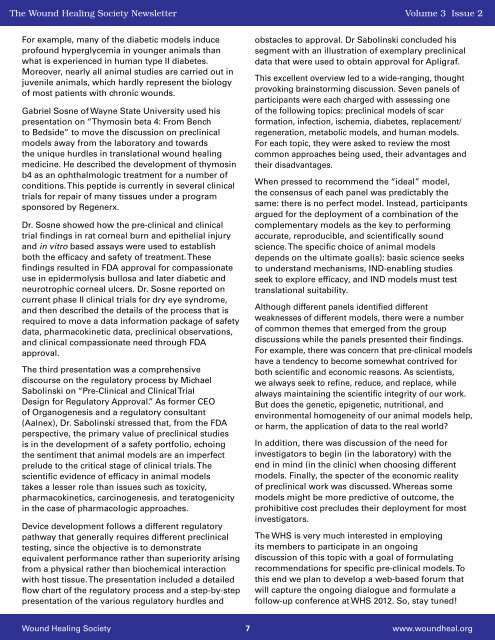

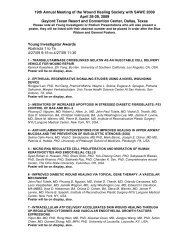

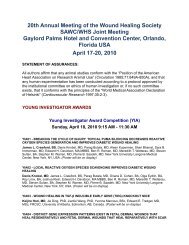
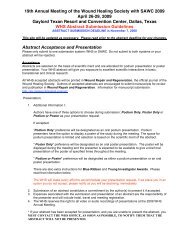
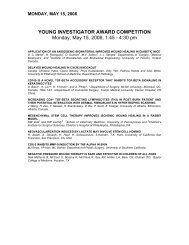

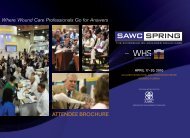

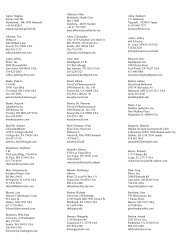
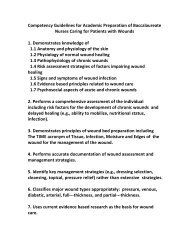
![2010 Abstracts-pah[2] - Wound Healing Society](https://img.yumpu.com/3748463/1/190x245/2010-abstracts-pah2-wound-healing-society.jpg?quality=85)